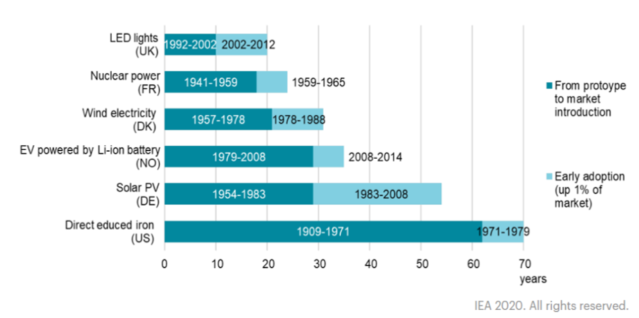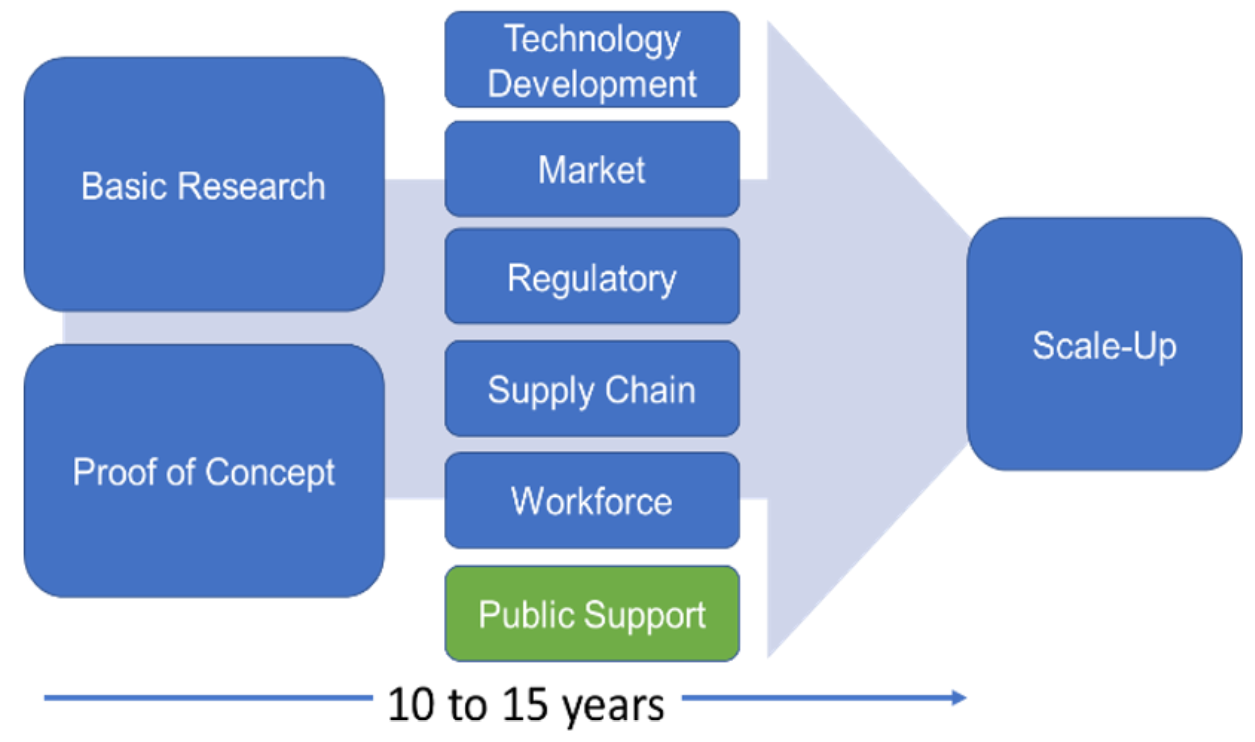Parallel Processing the Path to Commercialization of Fusion Energy
By: Sally M. Benson and Costa Samaras
Energy Team, Office of Science and Technology Policy, Executive Office of the President
What?! A path to commercialization of fusion energy? Fusion energy – that powers the stars – hasn’t yet been developed here on Earth in a way that produces more energy than it takes to sustain the fusion reaction. Not yet. But as we heard at the White House Fusion Summit[1] in March, this past year was a banner year for fusion – with major technical achievements in fusion technology coming in fast succession:
- a privately-funded U.S. fusion company demonstrated its prototype 20-tesla high-temperature-superconducting magnet, opening up an exciting new high-field, compact approach to commercial fusion energy[2],
- the first central-solenoid magnet was delivered for the international collaborative fusion experiment ITER, illustrating fusion-scale manufacturing capability of U.S. industry[3],
- the Joint European Torus (JET) in the UK doubled its 24-year-old record with a five-second, high-power pulse, limited only by the experimental hardware and not the plasma stability[4],
- Lawrence Livermore National Laboratory’s National Ignition Facility (NIF) in California achieved an energy yield eight times higher than its previous record and reached the cusp of ignition, providing us a second fusion approach with similar physics performance as the tokamak[5], and
- China’s Experimental Advanced Superconducting Tokamak (EAST) sustained fusion reactions for 17 minutes at 126 million degrees Fahrenheit – five times hotter than the sun[6].
Anticipating these coming breakthroughs, the Fusion Energy Science Advisory Committee[7] and the National Academies of Sciences and Engineering[8], recommended that the government accelerate its research and development programs to develop a fusion pilot plant. Private sector innovators and investors have gotten in gear – raising over $4 billion total, with about $2 billion in 2021 alone, aiming towards proof-of-concept demonstrations before the end of the decade.
At the White House Fusion Summit co-hosted by the Office of Science and Technology Policy and the Department of Energy, Secretary Granholm announced the creation of a department-wide initiative to launch a bold decadal action plan for accelerating the development of fusion energy. This week – Scott Hsu, the head of the new initiative, is hosting a workshop to get input on the public-private partnerships, a key element of the decadal strategy. One of the topics is how to smooth the path to commercialization – so that once the technology is ready to go, it can scale up quickly.
Energy technologies are notoriously slow to make their way between proof-of-concept and commercialization, averaging about 30-50 years[9] (Figure 1). In a world fighting the dangers of climate change and with increasing energy demands from developing economies around the world, we simply don’t have the time to wait. We need all the clean technology we can get, as soon as is humanly possible. Fusion is one of the critical technologies that, if successful, would be a game-changer for addressing these issues.

There are many reasons why the path to technology commercialization is often slow: the R&D needed for technology maturation and cost reduction; developing regulatory requirements and compliance mechanisms; market development; supply chain development; workforce development; and public support for technology adoption. All of these must be in place before rapid scale-up can begin. Historically – these activities would occur sequentially, explaining why the long path from proof-of-concept to commercialization is so slow. If we’re going to succeed in getting fusion to launch more quickly, we need to do things differently. We need to do all of these critical steps concurrently (Figure 2). Just like a computer that runs several processors simultaneously to handle different parts of a big problem, we can use parallel processing to accelerate the commercialization of fusion energy. In other words, we need to take the multiple steps today for successful development of fusion energy, so we are ready for scale-up as soon as the technology meets the safety, cost, performance, and reliability standards expected of new energy technologies. This week DOE will be getting stakeholder input about concreate actions that can be taken to pursue this parallel processing strategy, and the Administration will be diving in to develop a decadal plan for fusion commercialization.

Market Development
For new technologies to gain market share: applications for the technology need to be developed, the cost at which they can be developed must make them attractive to investors to warrant building the factories and supply chains needed to scale them up, customers must want to buy them, and enough supply must be available to meet growing demand. For fusion, this means thinking beyond electricity production exclusively, to include end-uses that benefit from a 24/7 source of electricity and heat. Applications such as hydrogen production, water desalination, direct air capture of CO2, and electrofuel and chemical production, are all good candidates for fusion energy. Now is the time to start imagining and developing the applications for fusion energy that will help grow the market quickly.
Regulatory Frameworks
Getting the right regulatory framework and processes in place to license construction and operation is key to the successful deployment and scaleup of fusion energy facilities. We need regulations that provide a high degree of protection for workers, the public, and the environment. At the same time, the processes for getting permits for siting, construction, and operations must be predictable and quick enough to encourage broad deployment on the timescales needed to address the climate crisis. The Nuclear Regulatory Commission is currently soliciting feedback from stakeholders to provide input on developing an approach for regulating the fusion industry – recognizing that fusion is not a technology, but a physical process. Just like combustion, there are many ways for fusion to occur. There are different fuels that can be used for fusion; for example, fusion can be done using deuterium-tritium reaction, or a deuterium-deuterium reaction, or a boron-hydrogen reaction. Fusion can also be done using different technologies: tokamaks, stellarators, reverse-field configurations and more are being pursued by innovators today. Avoiding a one-size-fits-all approach that doesn’t account for the different characteristics and risks of different approaches will provide the flexibility needed to support the rapid scale-up of fusion energy facilities. But, the list of regulatory issues doesn’t stop here. We need to begin work on harmonizing international licensing standards and permitting processes to support export markets, including building in the appropriate safeguards and non-proliferation measures to underpin export control regulations.
Supply Chains
These days we are all acutely aware of the vulnerability of supply chains to geopolitical disruptions, pandemics, and worker shortages. This is why the Biden-Harris administration has taken action[10] to secure the supply chains for a robust clean energy transition. Supply chain security is also a key issue for fusion commercialization. For example, one pathway to fusion is enabled by high-temperature super-conducting magnets made with the rare-earth element yttrium. You may not know what yttrium is, but you need to know that we import nearly 100% of our yttrium consumption from one country. We also import 100% of the niobium used to generate the magnetic fields for other fusion pathways. From high temperature superconductors to high voltage power electronics, the U.S. is far too dependent on supply chains with single points of failure. As fusion technology develops, we must also concurrently identify the supply chain vulnerabilities and bottlenecks, build a resilient fusion supply chain, build a robust U.S. fusion manufacturing base, and build international partnerships to diversify production of critical materials and components. Fusion can be a part of a clean energy future that’s made in America, and we must build the secure supply chains that underpin the clean energy transition.
Workforce
Fusion brings the possibility of an entirely new clean industry, with the potential for good-paying jobs that design, build, operate, and maintain a new source of clean energy for the U.S. and the world. This workforce should look like America, and be diverse, equitable, and inclusive so that everyone has a chance to participate. Ramping up multidisciplinary investments to train a diverse fusion research and technical workforce will enable the U.S. to maintain our technological leadership. Capturing a star in a bottle with fusion energy to help solve the climate crisis has the potential to excite an entire new generation of American students and workers across all skillsets. The country will benefit if this time, everyone is welcomed, included, and supported. This new fusion workforce also needs state-of-the-art experimental facilities in the U.S. with the advanced equipment needed to solve the remaining challenges. From the workforce, to the facilities, to ultimately the fusion power plants, it is time to build.
Public Support
We have to get fusion technology right, and with the unrivalled expertise of America’s scientific and entrepreneurial ecosystem, we will. But getting the technology right is not enough. Successful adoption and deployment of fusion energy requires earning trust with communities right from the beginning. It starts with engaging communities about the benefits of fusion and listening to and responding to community concerns with workable solutions. It requires partnerships and a new social compact to enable communities to have a voice, and participate in and benefit from this new industry. And it requires incorporating environmental justice from the beginning of a technology development, rather than at the end. An inclusive approach will ensure that the harmful mistakes of past technology and infrastructure development are not repeated, and that every community can benefit from a transition to clean energy. This is what clean energy innovation for all looks like, and deploying existing technologies while aggressively innovating for the future represents the fastest and most equitable pathway to a net-zero emissions economy in the United States. Fusion energy can play a game-changing role in that clean energy transition, if we act boldly today.
###
[1] The White House (2022). Readout of the White House Summit on Developing a Bold Decadal Vision for Commercial Fusion Energy. https://www.whitehouse.gov/ostp/news-updates/2022/04/19/readout-of-the-white-house-summit-on-developing-a-bold-decadal-vision-for-commercial-fusion-energy/
[2] MIT (2021). MIT-designed project achieves major advance toward fusion energy. https://news.mit.edu/2021/MIT-CFS-major-advance-toward-fusion-energy-0908
[3] ITER (2021). 1st delivery celebrated on both sides of the Atlantic. https://www.iter.org/newsline/-/3653
[4] Gibney, E. (2022). Nuclear-fusion reactor smashes energy record. https://www.nature.com/articles/d41586-022-00391-1
[5] Lawrence Livermore National Laboratory (2021). National Ignition Facility experiment puts researchers at threshold of fusion ignition. https://www.llnl.gov/news/national-ignition-facility-experiment-puts-researchers-threshold-fusion-ignition
[6] Gamillo, E. (2022). China’s Artificial Sun Just Broke a Record for Longest Sustained Nuclear Fusion. https://www.smithsonianmag.com/smart-news/chinas-artificial-sun-reactor-broke-record-for-nuclear-fusion-180979336/
[7] Fusion Energy Sciences Advisory Committee (FESAC) (2020). Powering the Future: Fusion and Plasmas. https://science.osti.gov/-/media/fes/fesac/pdf/2020/202012/FESAC_Report_2020_Powering_the_Future.pdf
[8] National Academies of Sciences, Engineering, and Medicine (2021). Bringing Fusion to the U.S. Grid. https://nap.nationalacademies.org/catalog/25991/bringing-fusion-to-the-us-grid
[9] IEA (2020). Clean Energy Innovation. https://www.iea.org/reports/clean-energy-innovation
[10] DOE (2022). Securing America’s Supply Clean Energy Chain, https://www.energy.gov/policy/securing-americas-clean-energy-supply-chain

